Braid Stitch is part of the Chain stitch family. Known also as Cable Plait stitch and Gordian knot stitch, it is a linear stitch that creates a textured braided solid line. It holds curves well even though it is slightly raised. Braid stitch can be used anywhere that you need a solid line or a fine border.
This stitch can be worked on plain or even-weave fabrics in a thread with a firm twist such as cotton perle #8 or #5. Stranded floss is too flat to work this stitch well. When working on an even-weave fabric, one or two of the fabric threads can be drawn out behind the stitches to produce a lacy look.
Important tip! Work each stitch snug to its neighbour, as this stitch depends on firm braiding to be successful. Braid Stitch needs to be worked in a narrow band and with each stitch close together to stay in place. If it pops up, looks loose, or falls apart you either need to work each stitch closer together, or work the line narrower. If you don’t want to work it narrower, increase the thickness of your thread. Braid Stitch is tricky even for intermediate to advanced stitchers as the tension is important, so work it in a hoop.
How to work Braid Stitch
The stitches should be kept close together, small less than 5mm (1/4 in) high, otherwise the loops slip and become loose, and pull out of shape as the braided effect is lost.
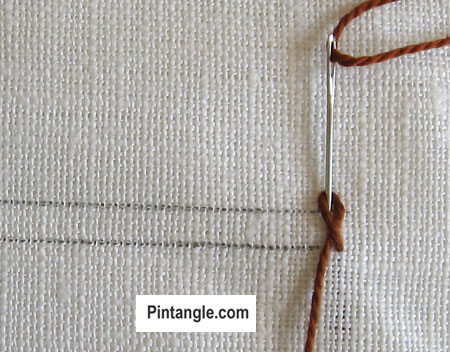
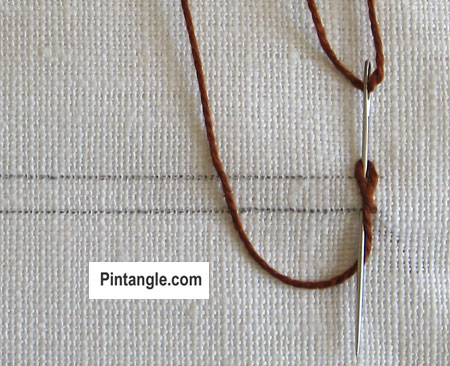

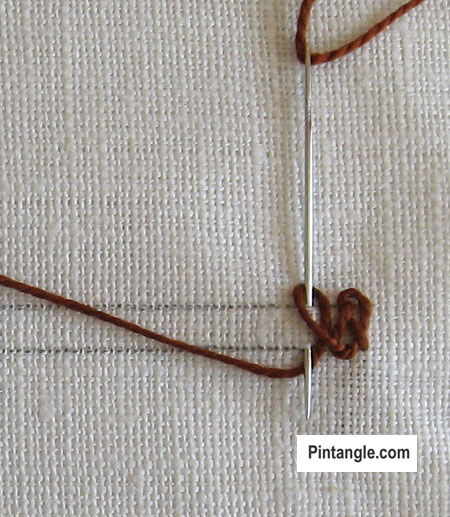
Bring the needle up through the fabric at the base of the line. Make a loop with your needle as illustrated. Note that the thread is passing underneath and is to the left of where the thread came up from the fabric. The top thread is wrapped to the right. I make a little loop with my fingers, lay it on the fabric then poke my needle into it. Once I am in the rhythm I wrap the thread around the needle but to start I make a loop. Clumsy I know but it works! I then insert the needle on the top line.
Bring the needle out on the bottom line directly below where it is inserted. Do not have the needle on the diagonal.
Wrap the thread under the needle.
Pull the needle through the fabric in a downwards motion to create the first stitch.
Continue repeating these steps, making sure you keep your stitches close together. In the photograph above, I have opened out the stitch a little so that you can see what is happening — but normally you would work the stitch closer to the previous one.

Keep each close together, otherwise, the loops slip and become loose.
I hope you enjoy Braid stitch!
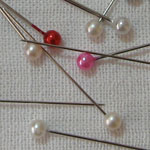 Follow Pintangle and have it delivered to your inbox
Follow Pintangle and have it delivered to your inbox
You can have Pintangle delivered to your inbox by using the subscribe feature in the sidebar. Enter your email address, and respond to the confirmation email to be all set!
If you are on a mobile or tablet, scroll to the bottom to find the subscribe feature.
Thread Twisties!
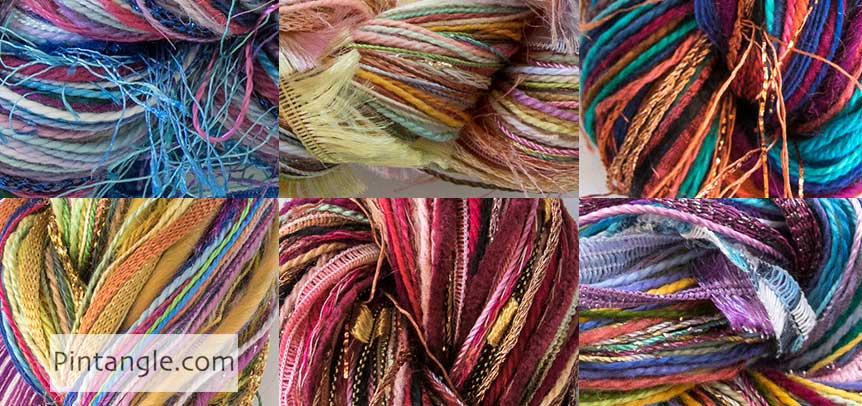
Experimenting with different threads can be expensive. You would normally have to buy a whole skein of each type of thread. My thread twisties are a combination of different threads to use in creative hand embroidery. These enable you to try out stitching with something other than stranded cotton. For the price of just a few skeins, you can experiment with a bundle of threads of luscious colours and many different textures.
These are creative embroiders threads. With them, I hope to encourage you to experiment. Each Twistie is a thread bundle containing silk, cotton, rayon and wool. Threads range from extra fine (the same thickness as 1 strand of embroidery floss) to chunky couchable textured yarns. All threads have a soft and manageable drape. Twisting them around a needle makes experimental hand embroidery an interesting journey rather than a battle. Many are hand dyed by me. All are threads I use. You may find a similar thread twist but no two are identical.
You will find my thread twisties in the Pintangle shop here.



I love your beautiful work. I used to sew about fifty years ago and decided to take it up again and make a crazy quilt for my first project. You are so encouraging and give directions that are clear and understandable. I look forward to being a member of your group. Thanks!
Thanks Connie enjoy stitching!
Thank you for showing us how to do this interesting stitch. Can’t wait to try it out!
Have fun with it Linda!